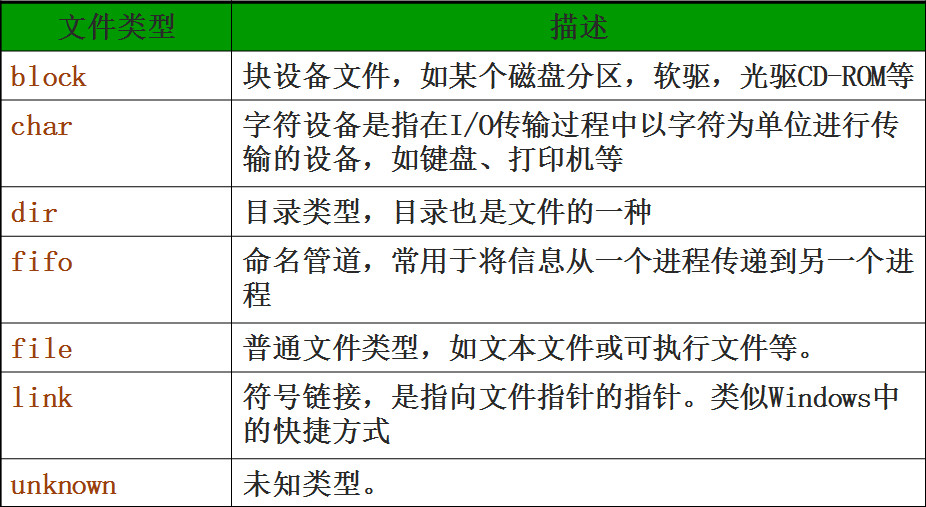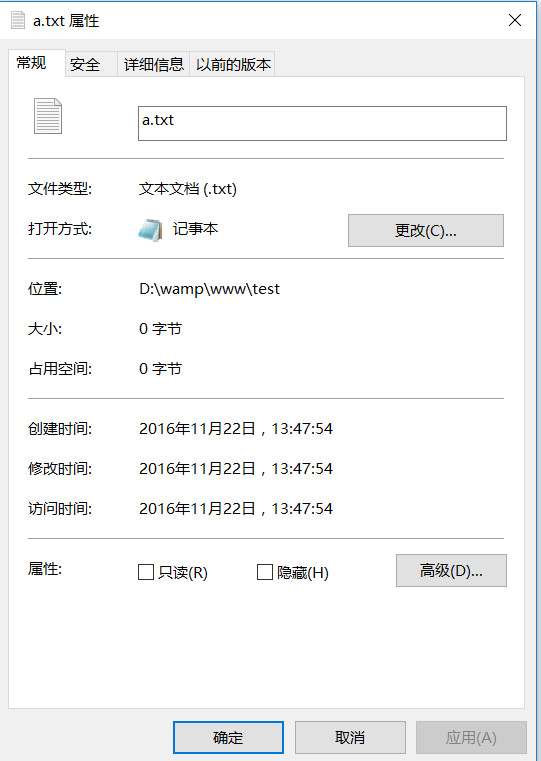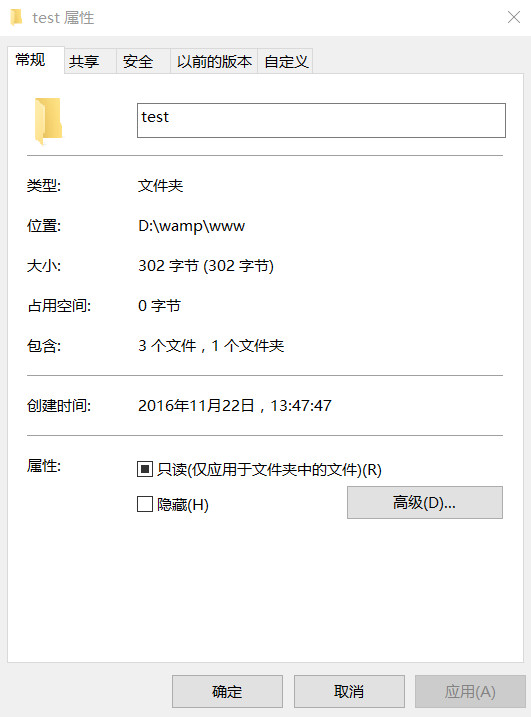前端学PHP之文件操作
前面的话
在程序运行时,程序本身和数据一般都存在内存中,当程序运行结束后,存放在内存中的数据被释放。如果需要长期保存程序运行所需的原始数据,或程序运行产生的结果,就需要把数据存储在文件或数据库。一般地,小型数据存储在文件中,海量数据存储在数据库中。本文主要介绍php中目录和文件的基本操作
文件类型
文件一般指存储在外部介质上具有名字(文件名)的一组相关数据集合。用文件可长期保存数据,并实现数据共享
PHP是以UNIX的文件系统为模型的。因此在Windows系统中我们只能获得”file”、”dir”或者“unknown”三种文件类型。而在UNIX系统中,我们可以获得block、char、dir、fifo、file、link和unknown七种类型

可以使用函数filetype()获取文件的具体类型,可能的值有fifo,char,dir,block,link,file 和 unknown
string filetype ( string filename )
如果出错则返回 FALSE。如果调用失败或者文件类型未知的话 filetype() 还会产生一个 E_NOTICE 消息
在服务器中新建一个目录test,并在目录中新建一个文件a.txt

<?php
echo filetype('test/a.txt'); // file
echo filetype('test/'); // dir
echo filetype('test/b.txt'); // Warning: filetype(): Lstat failed for test/b.txt
?> 在这7种文件类型中,window系统常用的是'file'和'dir'这两种,它们配套的类型检测函数分别是is_dir( )和is_file( )
is_dir( )
判断给定文件名是否是一个目录。如果文件名存在并且是一个目录则返回 true,否则返回 false
bool is_dir(_name)
is_file( )
判断给定文件名是否为一个正常的文件,如果文件存在且为正常的文件则返回 true
bool is_file(_name)
<?php
var_dump (is_file('test/a.txt')); //boolean true
var_dump (is_dir('test/')); //boolean true
?>
文件属性
一般地,在文件或目录右键菜单中,选择属性,即可查看文件的属性

下表中列出了php中关于文件属性的常用函数

<?php
var_dump (file_exists('test/a.txt')); //boolean true
var_dump (filesize('test/a.txt')); // int 0
var_dump (is_readable('test/a.txt')); //boolean true
var_dump (is_writeable('test/a.txt')); //boolean true
var_dump (is_executable('test/a.txt')); //boolean false
var_dump (date("Y-m-d H:i:s",(filectime('test/a.txt'))));//string '2016-11-22 06:47:54' (length=19)
var_dump (date("Y-m-d H:i:s",(filemtime('test/a.txt'))));//string '2016-11-22 06:47:54' (length=19)
var_dump (date("Y-m-d H:i:s",(fileatime('test/a.txt'))));//string '2016-11-22 06:47:54' (length=19)
?>
目录路径
windows下的目录路径使用是正斜杠(\),而unix下的目录路径使用是反斜杠(/)
$unixPath="/var/www/html/index.php"; //在UNIX系统中的绝对路径,必须使用"/"分隔 $winPath="C:\\Appserv\\www\\index.php"; //在Windows系统的绝对路径,默认使用"\"分隔 $winPath2="C:/Appserv/www/index.php"; //在Windows系统中也可使用“/”分隔
因为在Windows系统中也可使用(/)分隔。所以,在PHP中,不论是什么操作系统,全部都使用反斜杠(/)代表路径分隔符号
在PHP中,还提供了一个常量DIRECTORY_SEPARATOR,以此来代表目录分隔符,但写起来较麻烦
<?php echo "c:".DIRECTORY_SEPARATOR."a".DIRECTORY_SEPARATOR."b".DIRECTORY_SEPARATOR."c"; //c:\a\b\c ?>
在windows下多个路径的分隔符使用分号(;)分隔,而unix下使用冒号(:)分隔

在PHP中,提供了一个常量PATH_SEPARATOR,用来在跨平台的情况下,表示多个路径之间的分隔符
<?php echo "aaa/ccc/ddd".PATH_SEPARATOR."/www/yyyy";//aaa/ccc/ddd;/www/yyyy ?>
换行
在window下,换行是\r\n,而在unix下,换行是\n。通常在写程序中,换行就以unix为准,写作\n
同样地,PHP提供了一个常量PHP_EOL,用来在跨平台的情况下,表示换行
.和..
在PHP中,.表示当前目录,..表示上一级目录
<?php
var_dump (file_exists('test/a.txt'));//boolean true
var_dump (file_exists('./test/a.txt'));//boolean true
var_dump (file_exists('../www/test/a.txt'));//boolean true
?> 根路径
有两种根路径需要进行区分,一种是客户端根路径,一种是服务器根路径
以我自己在d盘安装的wamp为例,客户端根路径指'd:\wamp\www\',而服务器根路径为为'd:\'
<?php
echo '<img src="/a.jpg">';//客户端根路径,相当于d:\wamp\www\a.jpg
mkdir('/hello');//服务器根路径,相当于d:\hello
?> 路径解析函数
【basename()】
basename()函数用于返回路径中的文件名部分
<?php
echo "1) ".basename("/etc/sudoers.d", ".d");//1) sudoers
echo "2) ".basename("/etc/passwd").PHP_EOL;//2) passwd
echo "3) ".basename("/etc/").PHP_EOL;//3) etc
echo "4) ".basename(".").PHP_EOL;//4) .
echo "5) ".basename("/");//5)
?> 【dirname()】
dirname()函数用于返回路径中的目录部分
<?php
echo "1) " . dirname("/etc/passwd") . PHP_EOL; // 1) /etc
echo "2) " . dirname("/etc/") . PHP_EOL; // 2) \
echo "3) " . dirname("."); // 3) .
?> 【pathinfo()】
pathinfo()函数用于返回文件路径的信息
<?php
$path_parts = pathinfo('/www/htdocs/inc/lib.inc.php');
echo $path_parts['dirname'], "\n";// '/www/htdocs/inc' 目录名
echo $path_parts['basename'], "\n";// 'lib.inc.php' 文件名
echo $path_parts['extension'], "\n";// 'php' 文件后缀
echo $path_parts['filename'], "\n"; // 'lib.inc' 文件名不带后缀
?> 【realpath()】
realpath()函数用于返回规范化的绝对路径名
在Windows上,realpath()会将unix风格的路径改成Windows风格的
<?php
echo realpath('/wamp');// 'D:\wamp'
?>
目录遍历
glob()
glob()函数用于寻找与模式匹配的文件路径
array glob ( string $pattern [, int $flags = 0 ] )
在www目录下新建a.txt和b.txt文件
<?php
foreach (glob("*.txt") as $filename) {//a.txt size 1050 b.txt size 73echo "$filename size " . filesize($filename) . "\n";
}
?> opendir()
opendir()函数用于打开目录句柄。如果成功则返回目录句柄的resource,失败则返回 FALSE
resource opendir ( string $path [, resource $context ] )
<?php
var_dump(opendir('test'))//resource(3, stream)
?> closedir()
closedir()函数用于关闭目录句柄
void closedir ([ resource $dir_handle ] )
参数dir_handle表示目录句柄的 resource,之前由 opendir()所打开的。如果目录句柄没有指定,那么会假定为是opendir()所打开的最后一个句柄
<?php
$dir = opendir('test');
closedir($dir);
?> readdir()
readdir()函数用于从目录句柄中读取条目,返回目录中下一个文件的文件名。文件名以在文件系统中的排序返回,失败时返回 FALSE
string readdir ([ resource $dir_handle ] )
在www目录下新建目录test,并在目录test下新建a.txt和b.txt文件
<?php
$dir = opendir('test');
echo readdir($dir)."<br>";//.
echo readdir($dir)."<br>";//..
echo readdir($dir)."<br>";//a.txt
echo readdir($dir)."<br>";//b.txt
echo readdir($dir)."<br>";//
closedir($dir);
?> 在遍历目录时,每个目录的前两个返回值都是.和..,.代表当前目录,..代表上一级目录
所以,一般地,列出当前目录的所有文件并去掉 . 和 ..,常采用下面的代码
<?php
if ($handle = opendir('test')) {while (false !== ($file = readdir($handle))) {if ($file != "." && $file != "..") {echo "$file\n";}}closedir($handle);
}
?> 接下来,在test目录下,新建一个目录in,并在in目录中新建文件c.txt。然后,目录和文件区分显示
[注意]通过is_dir()函数判断目录时,需要加入路径
<?php
if ($handle = opendir('test')) {while (false !== ($file = readdir($handle))) {if ($file != "." && $file != "..") {$file = "test/".$file;if(is_dir($file)){echo "目录:".$file."<br>";}else{echo "文件:".$file."<br>";}}}closedir($handle);
}
/*
文件:test/a.txt
文件:test/b.txt
目录:test/in*/
?> rewinddir()
rewinddir()函数用于倒回目录句柄,将参数dir_handle指定的目录流重置到目录的开头
void rewinddir ( resource $dir_handle )
如果不使用rewinddir()函数,则文件只能遍历一次
<?php
if ($handle = opendir('test')) {while (false !== ($file = readdir($handle))) {if ($file != "." && $file != "..") {$file = "test/".$file;if(is_dir($file)){echo "目录:".$file."<br>";}else{echo "文件:".$file."<br>";}}}while (false !== ($file = readdir($handle))) {if ($file != "." && $file != "..") {$file = "test/".$file;if(is_dir($file)){echo "目录:".$file."<br>";}else{echo "文件:".$file."<br>";}}}closedir($handle);
}/*
文件:test/a.txt
文件:test/b.txt
目录:test/in*/
?> 使用rewinddir()函数,可以把目录句柄返回到第一个文件,从而实现重新遍历
<?php
if ($handle = opendir('test')) {while (false !== ($file = readdir($handle))) {if ($file != "." && $file != "..") {$file = "test/".$file;if(is_dir($file)){echo "目录:".$file."<br>";}else{echo "文件:".$file."<br>";}}}rewinddir($handle);while (false !== ($file = readdir($handle))) {if ($file != "." && $file != "..") {$file = "test/".$file;if(is_dir($file)){echo "目录:".$file."<br>";}else{echo "文件:".$file."<br>";}}}closedir($handle);
}/*
文件:test/a.txt
文件:test/b.txt
目录:test/in
文件:test/a.txt
文件:test/b.txt
目录:test/in*/
?>
目录统计
disk_total_space()
disk_total_space()函数返回一个目录的磁盘总大小
float disk_total_space ( string $directory )
<?php
$ds = disk_total_space("C:");
echo $ds."<br>";//126652637184
$ds = disk_total_space("D:");
echo $ds;//1000202240000
?> disk_free_space()
disk_free_space()函数返回目录中的可用空间
float disk_free_space ( string $directory )
<?php
$ds = disk_free_space("C:");
echo $ds."<br>";//86087041024
$ds = disk_free_space("D:");
echo $ds;//481647472640
?> 下面来统计在www文件夹下新建的test目录的个数
<?php$dirn = 0; //目录数$filen = 0; //文件数//统计一个目录下的文件和目录的个数function getdirnum($file) {global $dirn;global $filen; $dir = opendir($file);while (false !== ($filename = readdir($dir))) {if($filename!="." && $filename !="..") {$filename = $file."/".$filename; //更新路径if(is_dir($filename)) {$dirn++;getdirnum($filename); //递归,就可以查看所有子目录} else {$filen++; }}}closedir($dir);}getdirnum("test");echo "目录数为:{$dirn}<br>";//目录数为:1echo "文件数为:{$filen}<br>";//文件数为:3
?> 下面来统计在www文件夹下新建的test目录的大小
<?php//统计目录大小function dirsize($file) {$size = 0;$dir = opendir($file);while(false !== ($filename = readdir($dir))) {if($filename!="." && $filename !="..") {$filename = $file."/".$filename;if(is_dir($filename)) {$size += dirsize($filename);//使用递归} else {$size += filesize($filename);}}}closedir($dir);return $size;}
echo "test目录大小为:".dirsize("test")."<br>";//test目录大小为:302
?> 
目录增删
mkdir()
mkdir()函数用于新建目录
bool mkdir ( string $pathname [, int $mode = 0777 [, bool $recursive = false [, resource $context ]]] )
rmdir()
rmdir()函数用于删除目录
bool rmdir ( string $dirname [, resource $context ] )
[注意]该目录必须是空的,而且要有相应的权限。失败时会产生一个 E_WARNING 级别的错误
unlink()
unlink()函数用于删除文件
bool unlink ( string $filename [, resource $context ] )
下面来清空test目录
<?phpfunction deldir($dirname) {//如果是文件,直接删除即可if(is_file($dirname)) {unlink($dirname);}$dir = opendir($dirname);while(FALSE !== ($filename = readdir($dir))) {if($filename !="." && $filename!="..") {$filename = $dirname."/".$filename;if(is_dir($filename)) {deldir($filename);//递归}else {unlink($filename);//删除文件}}}closedir($dir);if($dirname != 'test'){rmdir($dirname);//删除目录}}deldir("test");
?>
目录复制
copy()
copy()函数用于拷贝文件
bool copy ( string $source , string $dest [, resource $context ] )
[注意]copy()函数不能用于复制目录
<?php $file = 'a.txt'; $newfile = 'a.bak'; copy($file, $newfile); ?>
rename()
rename()函数用于重命名一个文件或目录
bool rename ( string $oldname , string $newname [, resource $context ] )
[注意]rename()函数具有移动文件或目录的功能
下面把www目录下的test目录剪贴,命名为t,并移动到d盘目录下
<?php
rename("test", "d:/t");
?> 使用rename()只能实现剪切的操作,使用copy()只能复制文件。如果要复制目录,则需要使用循环和遍历
<?php/*** $dirsrc 原目录* $dirto 目标目录*/function copydir($dirsrc, $dirto) {//如果目录不存在,则新建一个目录if(!file_exists($dirto)) {mkdir($dirto);}$dir = opendir($dirsrc);while(FALSE !== ($filename = readdir($dir))) {if($filename != "." && $filename !="..") {$srcfile = $dirsrc."/".$filename; //原文件$tofile = $dirto."/".$filename; //目标文件if(is_dir($srcfile)) {copydir($srcfile, $tofile); //递归处理所有子目录}else{copy($srcfile, $tofile);//复制文件}}}}copydir("test", "d:/t");
?>
文件操作
touch()
touch()函数用来设定文件的访问和修改时间。如果文件不存在,则会被创建。成功时返回 TRUE, 或者在失败时返回 FALSE
bool touch ( string $filename [, int $time = time() [, int $atime ]] )
参数filename表示要设定的文件名,time表示要设定的时间。如果没有提供参数 time 则会使用当前系统的时间;atime表示如果给出了这个参数,则给定文件的访问时间会被设为atime,否则会设置为time。如果没有给出这两个参数,则使用当前系统时间
<?phptouch('abc.txt')
?> copy()
copy()函数用于拷贝文件
bool copy ( string $source , string $dest [, resource $context ] )
[注意]copy()函数不能用于复制目录
<?php $file = 'a.txt'; $newfile = 'a.bak'; copy($file, $newfile); ?>
rename()
rename()函数用于重命名一个文件或目录
bool rename ( string $oldname , string $newname [, resource $context ] )
[注意]rename()函数具有移动文件或目录的功能
<?php
rename("abc.txt", "d:/cba.txt");
?> unlink()
unlink()函数用于删除文件
bool unlink ( string $filename [, resource $context ] )
<?php
unlink("d:/cba.txt");
?>
文件内容
fopen()
fopen()函数用于打开文件或者URL,fopen()将 filename 指定的名字资源绑定到一个流上
fopen() 中 mode 的可能值列表
mode 说明 'r' 只读方式打开,将文件指针指向文件头。 'r+' 读写方式打开,将文件指针指向文件头。 'w' 写入方式打开,将文件指针指向文件头并将文件大小截为零。如果文件不存在则尝试创建之。 'w+' 读写方式打开,将文件指针指向文件头并将文件大小截为零。如果文件不存在则尝试创建之。 'a' 写入方式打开,将文件指针指向文件末尾。如果文件不存在则尝试创建之。 'a+' 读写方式打开,将文件指针指向文件末尾。如果文件不存在则尝试创建之。
<?php//使用绝对路径打开file.txt文件,选择只读模式,并返回资源$handle$handle = fopen("/home/rasmus/file.txt", "r");//访问文档根目录下的文件,也以只读模式打开$handle = fopen(“{$_SERVER['DOCUMENT_ROOT']}/data/info.txt", "r");//在 Windows 平台上,转义文件路径中的每个反斜线,或者用斜线,以二进制和只写模式组合$handle = fopen("c:\\data\\file.gif", "wb");//使用相对路径打开file.txt文件,选择只读模式,并返回资源$handle$handle = fopen("../data/info.txt", "r");//打开远程文件, 使用HTTP协议只能以只读的模式打开$handle = fopen("http://www.example.com/", "r");//使用FTP协议打开远程文件,如果FTP服务器可写,则可以以写的模式打开$handle = fopen("ftp://user:password@example.com/somefile.txt", "w");
?> fclose()
fclose()函数用于关闭一个已打开的文件指针
bool fclose ( resource $handle )
<?php
$handle = fopen('test/a.txt', 'r');
fclose($handle);
?> fwrite()
fwrite()函数用于写入文件(可安全用于二进制文件),返回写入的字符数,出现错误时则返回 FALSE
int fwrite ( resource $handle , string $string [, int $length ] )
当打开方式为只读模式时,无法向文件写入字符
<?php
$fp = fopen('test/a.txt', 'r');
echo fwrite($fp, '1');//0
echo "<br>";
echo fwrite($fp, '23');//0
echo "<br>";
fclose($fp);
?> 当打开方式为写模式时,可以向文件写入字符
<?php
$fp = fopen('test/a.txt', 'w');
echo fwrite($fp, '1');//1
echo "<br>";
echo fwrite($fp, '23');//2
echo "<br>";
fclose($fp);
/*
文件内容为123*/
?> 当打开方式为追加模式时,将向文件的尾部追加新的字符
<?php
$fp = fopen('test/a.txt', 'a');
echo fwrite($fp, '1');//1
echo "<br>";
echo fwrite($fp, '23');//2
echo "<br>";
fclose($fp);
/*
刷新两次时,文件内容为123123*/
?> fgetc()
fgetc()函数用于从文件指针中读取字符
[注意]使用fgetc()函数时,需要在fopen()函数中使用读模式
string fgetc ( resource $handle )
<?php
$fp = fopen('test/a.txt', 'r');
echo fgetc($fp);//1
echo fgetc($fp);//2
echo fgetc($fp);//3
fclose($fp);
?> feof()
feof()函数用于测试文件指针是否到了文件结束的位置
bool feof ( resource $handle )
<?php
$fp = fopen('test/a.txt', 'r');
while(!feof($fp)){echo fgetc($fp);//123123
}
fclose($fp);
?> fgets()
fgets()函数用于从文件指针中读取一行
string fgets ( resource $handle [, int $length ] )
将test目录下的a.txt文件内容修改为
aa bbb
<?php
$fp = fopen('test/a.txt', 'r');
echo fgets($fp);//'aa'
echo fgets($fp);//'bbb'
echo fgets($fp);//''
fclose($fp);
?> fread()
fread()函数用于读取文件(可安全用于二进制文件)。fread()从文件指针handle读取最多length个字节。该函数在读取了length个字节或到达了文件末尾(EOF)时将停止读取文件
string fread ( resource $handle , int $length )
<?php
$fp = fopen('test/a.txt', 'r');
echo fread($fp,3);//'aa '
fclose($fp);$fp = fopen('test/a.txt', 'r');
echo fread($fp,filesize('test/a.txt'));//'aa bbb'
fclose($fp);
?> fseek()
fseek()函数用于在文件指针中定位,成功则返回 0;否则返回 -1
int fseek ( resource $handle , int $offset [, int $whence = SEEK_SET ] )
将test目录下的a.txt文件内容修改为'12345'
<?php
$fp = fopen('test/a.txt', 'r');
echo fgetc($fp);//'1'
fseek($fp,4);
echo fgetc($fp);//'5'
fclose($fp);
?> <?php
$fp = fopen('test/a.txt', 'r');
echo fread($fp,2)."<br>";//12
fseek($fp,4);
echo fread($fp,2)."<br>";//5
fseek($fp,-3,SEEK_END);
echo fread($fp,2)."<br>";//34
fclose($fp);
?> ftell()
ftell()函数用于返回文件指针读/写的位置
int ftell ( resource $handle )
<?php
$fp = fopen('test/a.txt', 'r');
echo ftell($fp);//0
fgetc($fp);
echo ftell($fp);//1
fseek($fp,4);
echo ftell($fp);//4
fclose($fp);
?> rewind()
rewind()函数用于倒回文件指针的位置,将handle的文件位置指针设为文件流的开头
bool rewind ( resource $handle )
<?php
$fp = fopen('test/a.txt', 'r');
fseek($fp,2);
echo ftell($fp);//2
rewind($fp);
echo ftell($fp);//0
?> file_get_contents()
file_get_contents()函数用于将整个文件读入一个字符串
string file_get_contents ( string $filename [, bool $use_include_path = false [, resource $context [, int $offset = -1 [, int $maxlen ]]]] )
<?php
$homepage = file_get_contents('test/a.txt');
echo $homepage;//'12345'
?> 页面变为百度首页
<?php
$homepage = file_get_contents('http://www.baidu.com/');
echo $homepage;
?> file_put_contents()
file_put_contents()函数用于将一个字符串写入文件
int file_put_contents ( string $filename , mixed $data [, int $flags = 0 [, resource $context ]] )
使用该函数和依次调用 fopen(),fwrite() 以及 fclose() 功能一样
[注意]默认为写模式,若设置第三个参数为FILE_APPEND,则变为追加模式
<?php
file_put_contents('test/a.txt','abc');
?> readfile()
readfile()函数用于读取文件并写入到输出缓冲
int readfile ( string $filename [, bool $use_include_path = false [, resource $context ]] )
<?php
readfile('http://www.baidu.com/');//页面中显示百度首页
?>
<?php
readfile('test/a.txt');//页面中显示abc
?> file()
file()函数用于把整个文件读入一个数组中,每一行作为一个数组的元素
array file ( string $filename [, int $flags = 0 [, resource $context ]] )
将a.txt的文件内容改为每一行一个数字,分别是1、2、3、4、5、6、7、8、9
<?php
$arr = file('test/a.txt',0);
echo $arr[0]."<br>";//1
echo count($arr);//9
?> ftruncate()
ftruncate()函数用于将文件截断到给定的长度
bool ftruncate ( resource $handle , int $size )
[注意]使用ftruncate()函数时,需要使用追加模式。经测试,使用读模式时无效,使用写模式时,文件内容被清空
<?php
$fp = fopen("test/a.txt","a");
ftruncate($fp,100);
?> 



![BZOJ3130: [Sdoi2013]费用流[最大流 实数二分]](http://pic.xiahunao.cn/BZOJ3130: [Sdoi2013]费用流[最大流 实数二分])



)


 结果是几位数)
![[回归分析][10]--相关误差的问题](http://pic.xiahunao.cn/[回归分析][10]--相关误差的问题)






)
